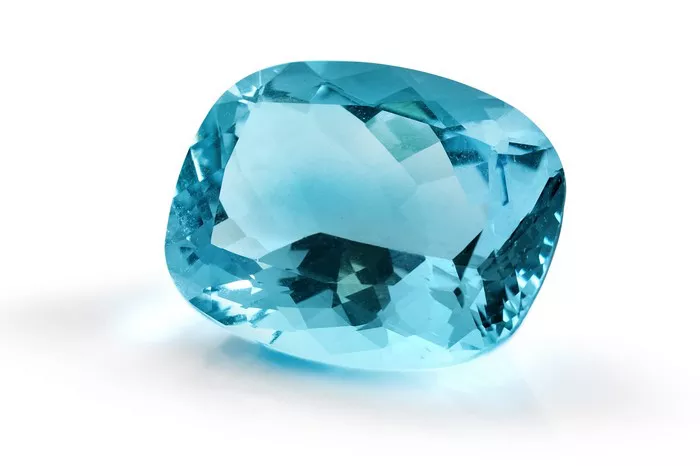Aquamarine, a stunning blue-green gem, derives its name from the Latin words “aqua” (water) and “marina” (of the sea), reflecting its mesmerizing ocean-like hue. Belonging to the beryl family, aquamarine is closely related to emerald, but is prized for its clarity and color, ranging from pale blue to deep blue-green. Knowing these fundamental aspects is essential when distinguishing genuine aquamarine from counterfeit stones.
Why Distinguishing Real from Fake Matters
With the rise of synthetic gems and sophisticated imitation techniques, it’s increasingly crucial to identify genuine aquamarine. Authentic aquamarine not only holds greater monetary value but also boasts the unique physical and metaphysical properties associated with natural gemstones. Counterfeit stones can be misleading in terms of both value and the gemstone’s inherent qualities.
Visual Inspection: Color, Clarity, and Cut
1. Color Examination: Real aquamarine exhibits a distinct blue to blue-green color, often with a crystal-clear appearance. The color should be uniform, although slight variations are natural. Counterfeit stones may display overly vivid or inconsistent hues, sometimes appearing too perfect or too dull.
2. Clarity Check: Authentic aquamarine is usually quite clear, with minimal inclusions. Natural inclusions, such as liquid-filled cavities or small fractures, can be present but should not significantly affect the stone’s transparency. Synthetic or fake aquamarine might show air bubbles or other unnatural inclusions.
3. Cut Quality: Examine the precision of the cut. Real aquamarine is often skillfully cut to enhance its brilliance and color. Look for sharp, clean edges and symmetrical facets. Poorly cut stones with uneven facets may indicate a fake.
Testing Techniques for Authenticity
1. Hardness Test: Aquamarine ranks 7.5 to 8 on the Mohs hardness scale. You can test this by attempting to scratch the stone with a material of known hardness. A real aquamarine will not scratch easily, whereas softer imitations might.
2. Refractive Index Measurement: Using a refractometer, measure the stone’s refractive index, which for aquamarine ranges between 1.577 and 1.583. Values outside this range suggest the stone might not be genuine.
3. Specific Gravity Test: Aquamarine has a specific gravity of approximately 2.68 to 2.74. A hydrostatic balance can determine this property, helping to differentiate real aquamarine from other stones with different densities.
Advanced Testing: Laboratory Certification and Professional Appraisal
1. Gemological Laboratory Testing: For conclusive verification, submitting the aquamarine to a reputable gemological laboratory is advisable. Labs like the Gemological Institute of America (GIA) or the American Gemological Laboratories (AGL) can provide detailed reports on the stone’s authenticity, origin, and quality.
2. Professional Appraisal: Consulting with a certified gemologist or appraiser can provide expert insight. They use advanced tools and techniques to assess the stone accurately and can offer a certificate of authenticity.
Common Counterfeit Materials and How to Spot Them
1. Glass: Often used to imitate aquamarine, glass lacks the hardness and clarity of real aquamarine. It may contain air bubbles and show a lower refractive index.
2. Synthetic Spinel: This material can closely mimic aquamarine but typically has a different refractive index and specific gravity. It also may show different fluorescence under UV light compared to natural aquamarine.
3. Blue Topaz: Frequently misrepresented as aquamarine, blue topaz is generally more intensely colored and exhibits a higher refractive index and specific gravity.
Natural vs. Treated Aquamarine
Understanding the difference between natural and treated aquamarine is vital. Heat treatment is commonly used to enhance the color of aquamarine, making pale stones appear more vibrant. While this does not make the stone fake, it does affect its value. Always ask for disclosure of any treatments when purchasing aquamarine.
Market Insights and Purchasing Tips
1. Buy from Reputable Sources: Purchasing from established and reputable jewelers or gem dealers ensures a higher likelihood of acquiring genuine aquamarine. Look for sellers who provide certification and detailed descriptions of the stones.
2. Price Awareness: Be wary of prices that seem too good to be true. Genuine aquamarine, especially high-quality stones, comes at a premium. Unrealistically low prices might indicate a fake.
3. Return Policies and Guarantees: Ensure the seller offers a return policy or satisfaction guarantee. This provides a safety net should the stone later prove to be inauthentic.
Caring for Your Aquamarine
Proper care and maintenance can help preserve the beauty and integrity of your aquamarine. Avoid exposing the stone to harsh chemicals or extreme temperatures. Clean it with mild soap and water, using a soft brush to remove any dirt or oils. Regular professional cleaning and inspection can also help maintain its luster and authenticity.
Conclusion
Understanding how to differentiate real aquamarine from fake is crucial for ensuring you enjoy the true value and beauty of this captivating gemstone. By employing a combination of visual inspection, basic tests, professional appraisal, and purchasing from reputable sources, you can confidently identify and cherish authentic aquamarine. Always remember that while genuine aquamarine offers lasting value and beauty, a counterfeit stone will never hold the same allure or worth.
FAQs
What are common materials used to imitate aquamarine?
Common imitations include glass, synthetic spinel, and blue topaz. These materials can be distinguished by their different physical and optical properties, such as hardness, refractive index, and specific gravity.
How can I tell if an aquamarine has been treated?
Heat treatment is common to enhance aquamarine’s color. Reputable sellers should disclose any treatments. Laboratory testing can also reveal if a stone has been treated.
Where should I buy aquamarine to ensure it’s genuine?
Purchase from established and reputable jewelers or gem dealers who provide certification and detailed descriptions of the stones. Ensure they offer return policies and satisfaction guarantees.
What should I look for in a certification of aquamarine?
A certification should come from reputable gemological laboratories, such as the Gemological Institute of America (GIA) or American Gemological Laboratories (AGL), detailing the stone’s authenticity, origin, and quality.

